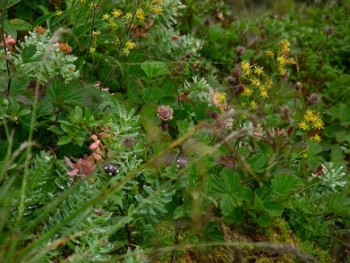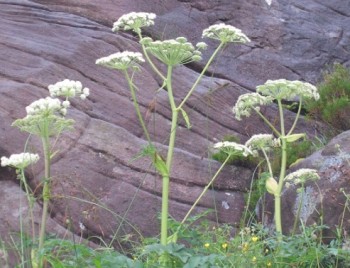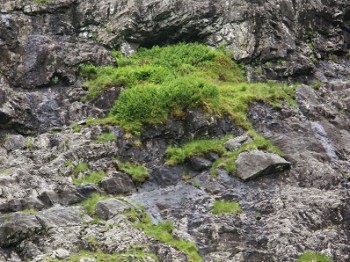Supporting guidance for Tall-herb Vegetation Management
Date published: 30 March, 2015
The Tall-herb Vegetation Management option supports tall-herb vegetation, which is scarce and supports several uncommon plant species.
It is typically found on upland cliff ledges and steeper slopes, where it is less accessible to grazing animals, or where grazing pressure is low.

Tall-herb vegetation, inclusing goldenrod, roseroot, water avens and alpine saw-wort – Credit: Tim Rafferty – © Scottish Natural Heritage
Wildlife benefits
Several types of tall-herb vegetation are found in the Scottish uplands. These are dominated either by a mixture of flowering herbs, ferns, or woodrush.
The flowering herbs include wild angelica, water avens, lady's mantle, meadowsweet, devil's-bit scabious, globe-flower, wood cranesbill and melancholy thistle.

Wild angelica – Credit: Graham Sullivan – © Scottish Natural Heritage

Tall-herb vegetation dominated by ferns – Credit: Phil James – © Scottish Natural Heritage
Where it is accessible, tall-herb vegetation can be heavily grazed and trampled, preventing flowering and seeding, and regeneration of young plants.
Eventually we can lose the species that make this vegetation special, leaving any remaining fragments vulnerable to chance events such as rockfall or landslip.
If grazing pressure is reduced or removed, the condition of grazed tall-herb vegetation can improve, with plants growing larger, flowering more and setting seed. Isolated fragments can expand into suitable adjacent areas.
This benefits biodiversity and makes the vegetation more resilient to pressures such as climate change.

Tall-herb vegetation growing where it's out of reach of grazers – Credit: Ruth Maier – © Scottish Natural Heritage
What needs to be done?
There are different ways of lowering grazing pressure to benefit this vegetation.
Sometimes, reducing grazing by livestock and wild herbivores in the wider area is sufficient. However, this vegetation is attractive to grazers, which may continue to graze it more than surrounding vegetation.
It is important to note that goats, which can access ground which is too difficult for deer or sheep, are particularly damaging.
The Stock Fence or Deer Fence capital items can give full control over grazing.
The aim is not to erect a fence tightly surrounding a patch of tall herbs, but to control grazing over a wider area to allow tall-herb vegetation to thrive and expand. You may need to exclude animals for some or all of the year.
How to increase the success of this option
Your grazing regime should take account of the extent and current condition of the tall-herb vegetation. Where tall herb vegetation has been heavily grazed it may recover after a period of exclusion from grazing.
Light grazing to remove rank growth can encourage tall herbs to regenerate. This is best done in autumn after seeds have shed.
To manage grazing you may choose to confine stock within a fenced area for a short period, or simply leaving a gate open to allow herbivores access.
Monitoring the effects of grazing on the vegetation will help ensure your grazing regime is appropriate. If livestock grazing is part of your management specify the grazing regime in the template provided.
To choose areas to be fenced, how big they are, and fence lines, take account of:
- the existing location and condition of tall-herb vegetation
- the need to include sufficient area suitable for tall herbs to expand into
- the practicalities of fence construction and maintenance in remote and difficult areas
- whether features such as rock faces or difficult ground provide an adequate barrier to supplement a fence
Further information
The different types of tall-herb vegetation are formed by specific combinations of species which fall into National Vegetation Classification (NVC) communities:
- U16 luzula sylvatica-vaccinium myrtillus tall-herb community (dominated by great woodrush and blaeberry, normally on fairly acidic soils)
- U17 luzula sylvatica-geum rivale tall-herb community (dominated by mixtures of tall flowering herbs, on lime-rich soils)
- U19 thelypteris limbosperma-blechnum spicant community (dominated by ferns, usually on thin, stony or rocky soils). You may need the help of a botanist or other specialist to help identify these vegetation types
They are also described in An Illustrated Guide to British Upland Vegetation (2004).
